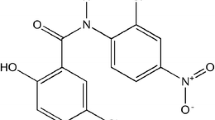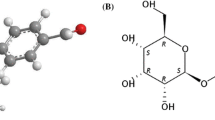Abstract
The interaction mechanism between nifedipine (NDP) and pepsin (PEP) at 298, 310, and 318 K was studied by various spectroscopic techniques and molecular docking. The experimental results showed that NDP mainly quenched the fluorescence of PEP by dynamic quenching of non-radiative energy transfer, but no significant changes in the secondary structure of PEP. The protein binding rate (W) of NDP measured at 310 K was 71.79–89.15%, and a binding rate model of NDP and PEP was established, W = − 0.1273R2 − 0.0519R + 0.8973. Hill’s coefficients were approximately 1, which showed that the interaction of NDP and PEP will not affect the binding of subsequent drug to the protein. The molecular docking technique was used to simulate the interaction between NDP and PEP, the results demonstrated that the binding site of NDP is located in the active center of pepsin, which was consistent with the conclusion of the spectroscopic method, and it was also proved that the interaction of PEP–NDP system was driven by hydrophobic and hydrogen bonding.
Graphical abstract










Similar content being viewed by others
References
Filgueira GCD, Filgueira OAS, Carvalho DM, Marques MP, Moisés ECD, Duarte G, Lanchote VL, Cavalli RC (2017) Br J Clin Pharmacol 83:1571
Li GC, Liu BS, Zhang QJ (2016) Luminescence 31:1054
Wang CD, Liu BS, Bian G, Ma LH (2017) Spectrosc Lett 50:476
Zhang QJ, Liu BS, Li GX, Han R, Lv YK (2016) Spectrosc Spect Anal 36:2879
Wang X, Liu Y, He LL, Liu B, Zhang SY, Ye X, Jing JJ, Zhang JF, Gao M, Wang X (2015) Food Chem Toxicol 78:42
Yang XL, Ye ZW, Yuan Y, Zheng ZQ, Shi JN, Ying Y, Huang P (2013) Luminescence 28:428
Sahu S, Bishi S, Behera PK (2011) J Mol Liq 158:39
Wang SJ, Peng YL, Zhang CG, Ma QP, Peng XX, Ren LL (2017) Bull Korean Chem Soc 38:740
Yin MM, Dong P, Chen WQ, Xu SP, Yang LY, Jiang FL, Liu Y (2017) Langmuir 33:5111
Liu ST, Tao HL, Shou HJ (2011) Chin J Anal Lab 30:12
Cui MM, Liu BS, Li TT, Duan ST (2016) Spectrosc Lett 49:575
Hemmateenejad B, Shamsipur M, Samari F, Khayamian T, Ebrahimi M, Rezaei Z (2012) J Pharmaceut Biomed 67–68:204
Wang T, Xiang BR, Li Y, Chen CY, Zhou XH, Wang ZM, Dong Y, Wang Y, Fang HS (2009) J Mol Struct 921:192
Zeng HJ, Yang D, Hu GZ, Yang R, Qu LB (2016) J Mol Recognit 29:481
Shen XC, Liang H, He XW, Wang XX (2004) Chin J Anal Chem 32:388
Chaves OA, Cesarin-Sobrinho D, Sant’Anna CMR, Carvalho MGD, Suzart LR, Catunda-Junior FEA, Netto-Ferreira JC, Ferreira ABB (2017) J Photochem PhotobiolA 336:37
Liu BS, Cao SN, Li ZY, Chong BH (2013) Chin J Lumin 34:489
Wang P, Xie SS, Guo JJ, Bu HZ, Chen XJ (2013) Chin J Clin Pharmacol Ther 18:939
Liu BS, Wang J, Xue CL, Yang C, Lü YK (2011) Z Phys Chem 225:461
Sun Y, Zhao YY, Li GB, Yang SY, Hu XY, Fan J (2011) J Chin Chem Soc (Taipei) 58:606
Sharifi T, Ghayeb Y, Mohammadi T (2017) Monatsh Chem 148:784
Fang YF, Xu H, Shen LL, Huang FW, Yibulayin S, Huang SY, Tian SL, Hu ZL, He ZD, Li FR, Li YO, Zhou K (2015) Luminescence 30:861
Wang GK, Wang DC, Li X, Lu Y (2011) Colloids Surf B 84:274
Zeng HJ, Li MT, Hu FF (2016) Chin J Lumin 37:484
Wang YR, Fang Q, Guo CH, Liu Y (2016) Spectrosc Spect Anal 36:3415
Sekowski S, Bitiucki M, Ionov M, Zdeb M, Abdulladjanova N, Rakhimov R, Mavlyanov S, Bryszewska M, Zamaraeva M (2018) J Lumin 194:171
Makarska-Bialokoz M (2018) Spectrochim Acta A 193:24
Agrahari AK, Doss CGP (2017) J Cell Biochem 118:3730
Shahidha R, Muthu S, Raja M, Raj MR, Narayana B, Nayak PS, Sarojini BK (2017) Optik 140:1127
Acknowledgements
The authors gratefully acknowledge the financial support of National Science Foundation of China (Grant no. 21375032).
Author information
Authors and Affiliations
Corresponding author
Rights and permissions
About this article
Cite this article
Ma, L., Liu, B., Wang, C. et al. The interaction mechanism of nifedipine and pepsin. Monatsh Chem 149, 2123–2130 (2018). https://doi.org/10.1007/s00706-018-2269-9
Received:
Accepted:
Published:
Issue Date:
DOI: https://doi.org/10.1007/s00706-018-2269-9




